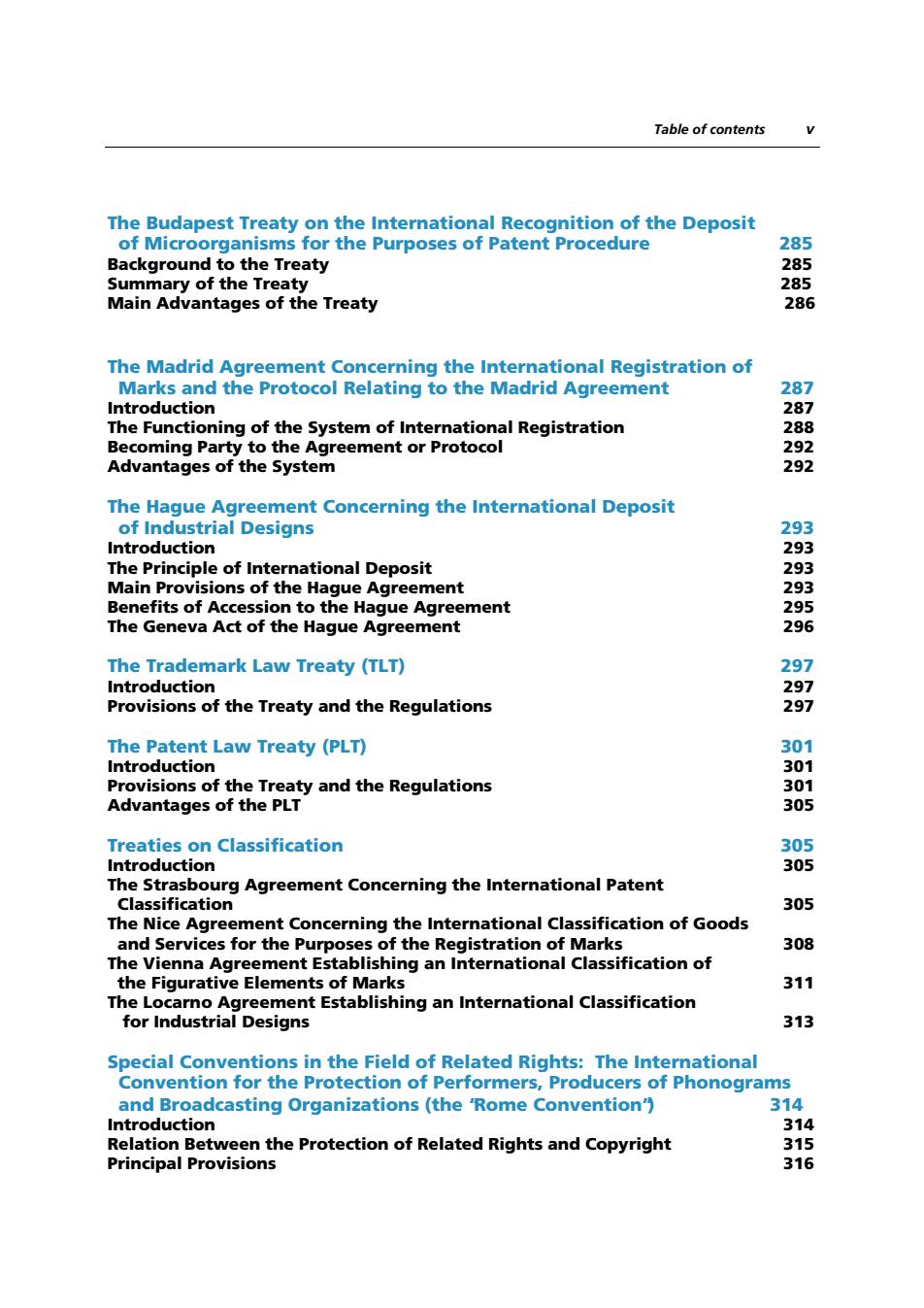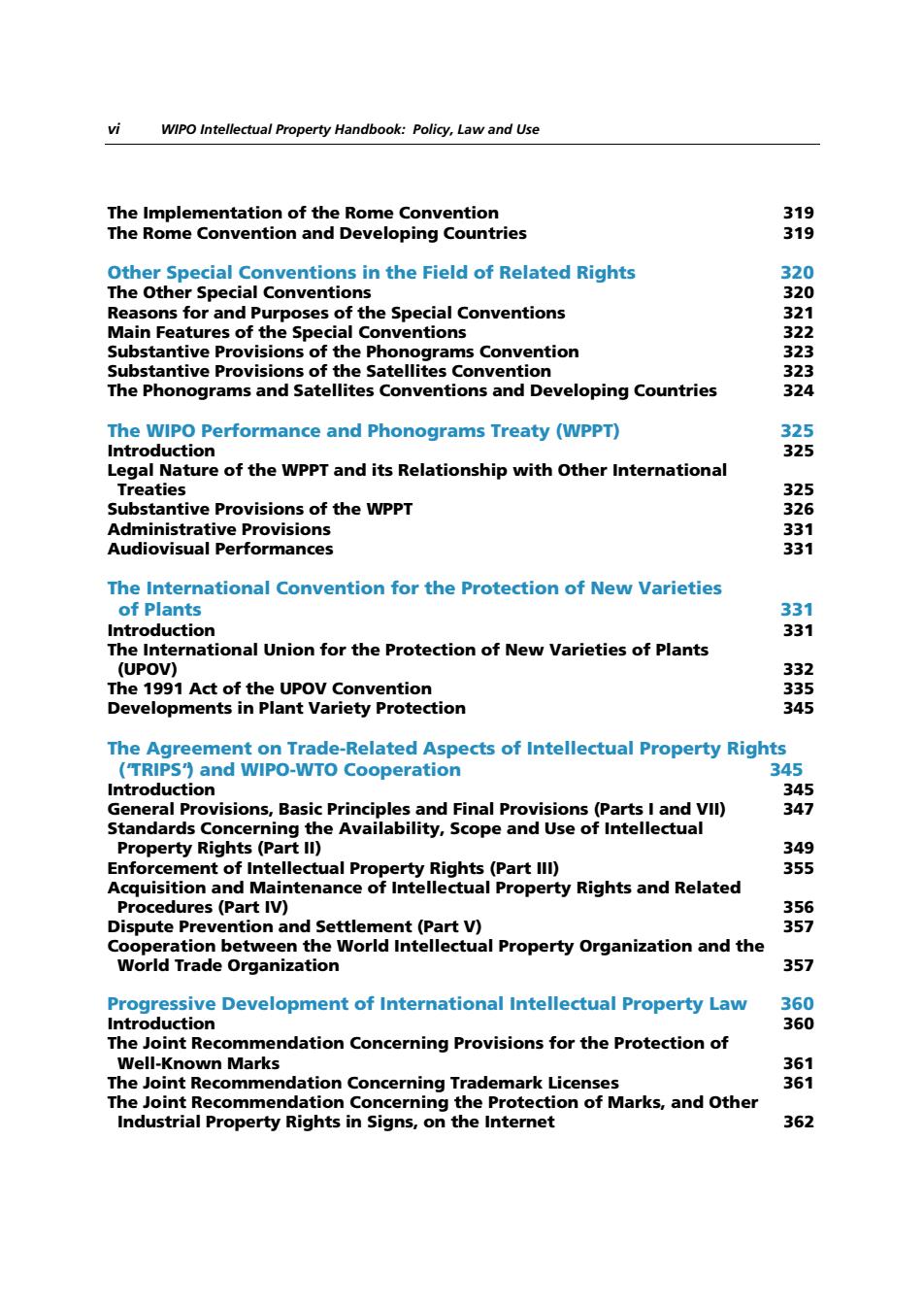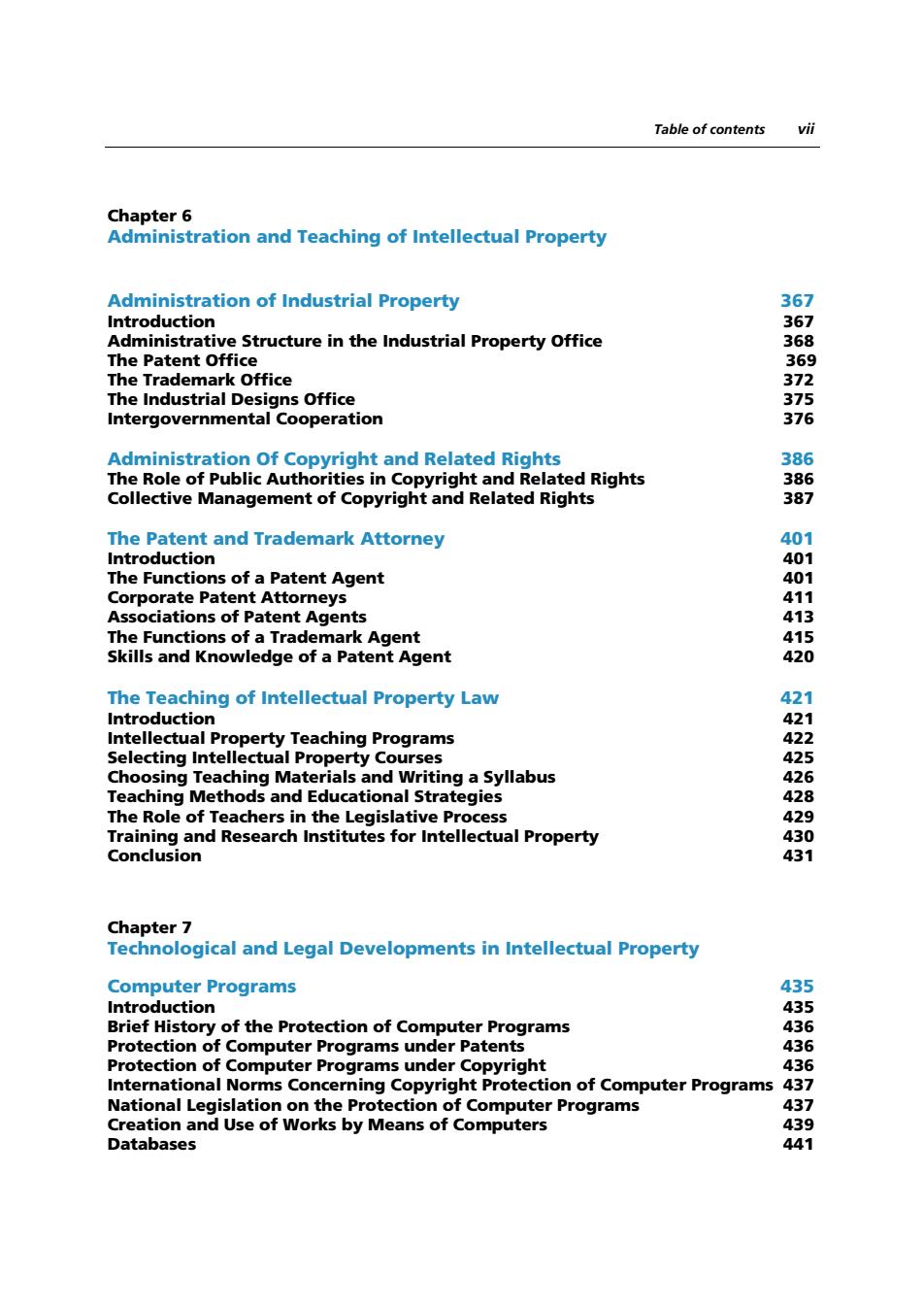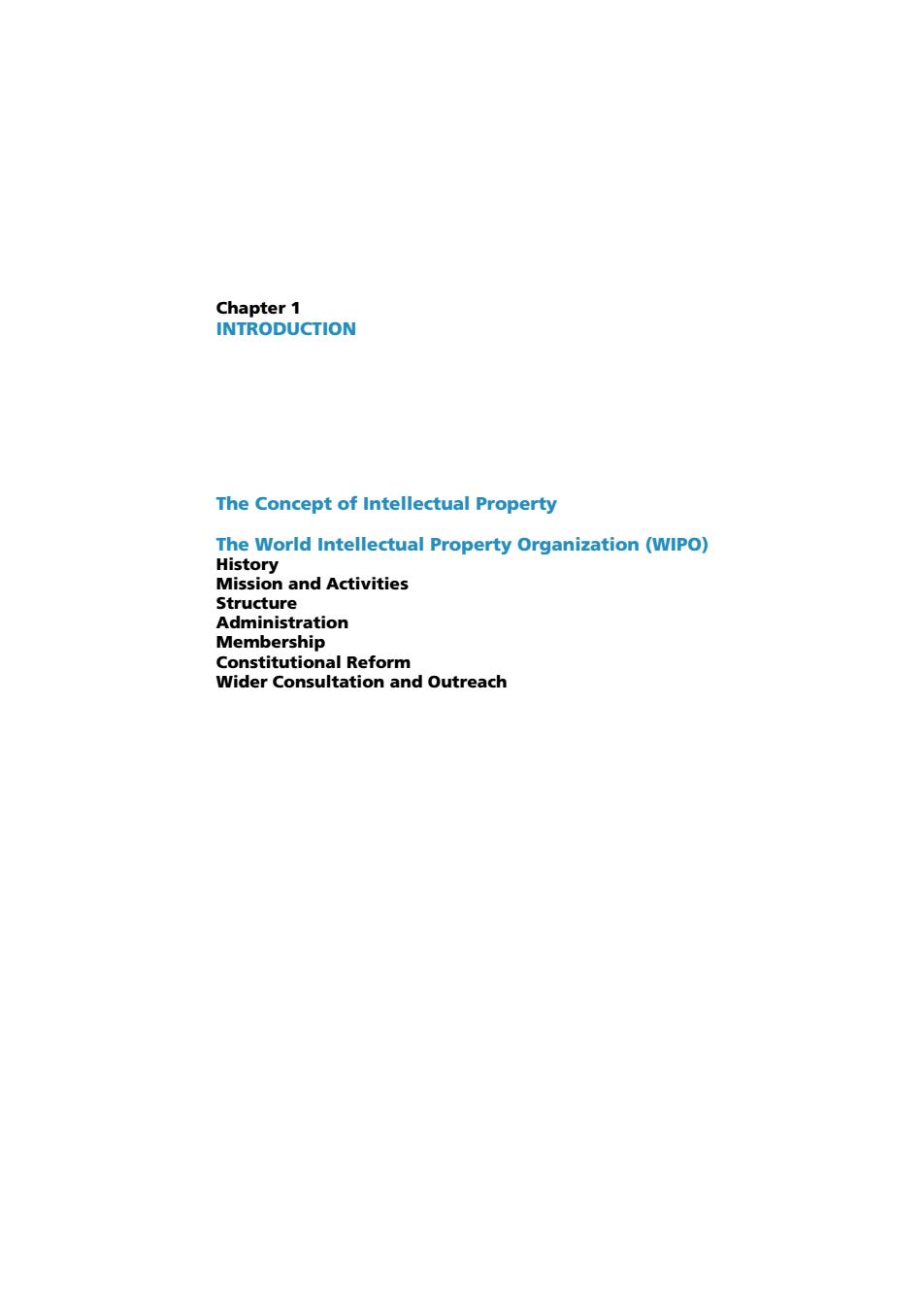
Table of contents v The Budapest Treaty on the International Recognition of the Deposit of Microorganisms for the Purposes of Patent Procedure tthe Treaty 285 Main Advantages of the Treaty The Madrid Agreement Concerning the International Registration of Marks and the Protocol Relating to the Madrid Agreement coming Party The Function mttatepmotie of Inte nal Registration 292 Advantages of the System 292 The Hag Designs 29 The Principle of International Deposit 293 Main Provisions of the Hag jue Agreement Act of e Agr ment The Trademark Law Treaty(TLT) 297 The Patent Law Treaty(PLT) 3 Introduction ons of the ty and the Regulations 8 Treaties on Classification 305 305 305 The Nice Ag ement Concerning the International Classification of Goods and Services for the Purpos es of the Registration of Marks 308 The Vie Agreement Esta ng an International Classification of ement Establishing an International Classification 311 for Industrial Designs 313 in the Field of el ent dcasting Organizations(the 'Rome Convention') 314 14 Relation Between the Protection of Related Rights and Copyright 315 Principal Provisions 316
Table of contents v The Budapest Treaty on the International Recognition of the Deposit of Microorganisms for the Purposes of Patent Procedure 285 Background to the Treaty 285 Summary of the Treaty 285 Main Advantages of the Treaty 286 The Madrid Agreement Concerning the International Registration of Marks and the Protocol Relating to the Madrid Agreement 287 Introduction 287 The Functioning of the System of International Registration 288 Becoming Party to the Agreement or Protocol 292 Advantages of the System 292 The Hague Agreement Concerning the International Deposit of Industrial Designs 293 Introduction 293 The Principle of International Deposit 293 Main Provisions of the Hague Agreement 293 Benefits of Accession to the Hague Agreement 295 The Geneva Act of the Hague Agreement 296 The Trademark Law Treaty (TLT) 297 Introduction 297 Provisions of the Treaty and the Regulations 297 The Patent Law Treaty (PLT) 301 Introduction 301 Provisions of the Treaty and the Regulations 301 Advantages of the PLT 305 Treaties on Classification 305 Introduction 305 The Strasbourg Agreement Concerning the International Patent Classification 305 The Nice Agreement Concerning the International Classification of Goods and Services for the Purposes of the Registration of Marks 308 The Vienna Agreement Establishing an International Classification of the Figurative Elements of Marks 311 The Locarno Agreement Establishing an International Classification for Industrial Designs 313 Special Conventions in the Field of Related Rights: The International Convention for the Protection of Performers, Producers of Phonograms and Broadcasting Organizations (the “Rome Convention”) 314 Introduction 314 Relation Between the Protection of Related Rights and Copyright 315 Principal Provisions 316

i WIPO Intellectual Property Handbook:Policy,Law and Use The Implementation of the Rome Convention 319 The Rome Convention and Developing Countries 319 Other Special Cor cial entions in the Field of Related Rights 8 asons for and pur ses of the Special Conventions 321 2 ain Features of the Special Conventions gr ms Co entio and Developing Countries The WIPO Performance and Phonograms Treaty(WPPT) 3部 Legal Nature of the WPPT and its Relationship with Other International Treaties 325 Substantive Provisions of the WPPT AimonistratirePprovisios ormance The International Convention for the Protection of New Varieties of Plants 381 onal Union for the Protection of New Varieties of Plants The 1991 Act of the UPOV Convention 36 Developments in Plant Variety Protection 345 The A n Trade-Related As WPO-WTOC pegRectoftnteiectualPropertyRign Introduction 345 General Provisions,Basic Principles and Final Provisions(Parts I and VIl) 347 an e Availa bility,Scope and Use of Intellectual ent of Intellectual Property Rights(Part Ill) 399 Acquisition and Maintenance of Intellectual Property Rights and Related res (Pa art Iv) ation betw en the World intelle t 355 ual Property Organization and the World Trade Organization 357 essive Development of International Intellectual Property Law 38 The Joint Recommendation Concerning Provisions for the Protection of nown Marks ing Tr m ark lic Marks 361 and Other Industrial Property Rights in Signs,on the Internet 362
vi WIPO Intellectual Property Handbook: Policy, Law and Use The Implementation of the Rome Convention 319 The Rome Convention and Developing Countries 319 Other Special Conventions in the Field of Related Rights 320 The Other Special Conventions 320 Reasons for and Purposes of the Special Conventions 321 Main Features of the Special Conventions 322 Substantive Provisions of the Phonograms Convention 323 Substantive Provisions of the Satellites Convention 323 The Phonograms and Satellites Conventions and Developing Countries 324 The WIPO Performance and Phonograms Treaty (WPPT) 325 Introduction 325 Legal Nature of the WPPT and its Relationship with Other International Treaties 325 Substantive Provisions of the WPPT 326 Administrative Provisions 331 Audiovisual Performances 331 The International Convention for the Protection of New Varieties of Plants 331 Introduction 331 The International Union for the Protection of New Varieties of Plants (UPOV) 332 The 1991 Act of the UPOV Convention 335 Developments in Plant Variety Protection 345 The Agreement on Trade-Related Aspects of Intellectual Property Rights (“TRIPS”) and WIPO-WTO Cooperation 345 Introduction 345 General Provisions, Basic Principles and Final Provisions (Parts I and VII) 347 Standards Concerning the Availability, Scope and Use of Intellectual Property Rights (Part II) 349 Enforcement of Intellectual Property Rights (Part III) 355 Acquisition and Maintenance of Intellectual Property Rights and Related Procedures (Part IV) 356 Dispute Prevention and Settlement (Part V) 357 Cooperation between the World Intellectual Property Organization and the World Trade Organization 357 Progressive Development of International Intellectual Property Law 360 Introduction 360 The Joint Recommendation Concerning Provisions for the Protection of Well-Known Marks 361 The Joint Recommendation Concerning Trademark Licenses 361 The Joint Recommendation Concerning the Protection of Marks, and Other Industrial Property Rights in Signs, on the Internet 362

Table of contents vi Chapter 6 Administration and Teaching of Intellectual Property Administration of Industrial Property 367 Structure in the Industrial Property Office The Trademark Office The Industrial De 37阳 Administration of Copvriaht and Related Rights The Role of Public Authorities in Copyright and Related Rights Collective Management of Copyright and Related Rights 游 rademark Attoey The Functions of a Patent Agent orporate e Pate f p Atto eys The of a tra gents Skills and Knowledge of a Patent Agent The Teaching of Intellectual Property Law Choosing Te eaching Materials and Writing a Syllabus g M no ar Strategie titutes Conclusion electual Property logical and Legal Developments in Intellectual Property Computer Programs of the P of Co Protection of Comput er prog Protection of Computer Programs unde ns Co n of C nputer Programs ation ar d Use of wo th ers Programs Databases 441
Table of contents vii Chapter 6 Administration and Teaching of Intellectual Property Administration of Industrial Property 367 Introduction 367 Administrative Structure in the Industrial Property Office 368 The Patent Office 369 The Trademark Office 372 The Industrial Designs Office 375 Intergovernmental Cooperation 376 Administration Of Copyright and Related Rights 386 The Role of Public Authorities in Copyright and Related Rights 386 Collective Management of Copyright and Related Rights 387 The Patent and Trademark Attorney 401 Introduction 401 The Functions of a Patent Agent 401 Corporate Patent Attorneys 411 Associations of Patent Agents 413 The Functions of a Trademark Agent 415 Skills and Knowledge of a Patent Agent 420 The Teaching of Intellectual Property Law 421 Introduction 421 Intellectual Property Teaching Programs 422 Selecting Intellectual Property Courses 425 Choosing Teaching Materials and Writing a Syllabus 426 Teaching Methods and Educational Strategies 428 The Role of Teachers in the Legislative Process 429 Training and Research Institutes for Intellectual Property 430 Conclusion 431 Chapter 7 Technological and Legal Developments in Intellectual Property Computer Programs 435 Introduction 435 Brief History of the Protection of Computer Programs 436 Protection of Computer Programs under Patents 436 Protection of Computer Programs under Copyright 436 International Norms Concerning Copyright Protection of Computer Programs 437 National Legislation on the Protection of Computer Programs 437 Creation and Use of Works by Means of Computers 439 Databases 441

vi WIPO Intellectual Property Handbook:Policy,Law and Use Biotechnology Tra Reprography Repr ography and Intellectual Property Audio and Video Recording 1444444 Satellites stril bution Systems et Elestronic Commerce A Complementary Approach to the Development of Intellectual Propert WIPO 51 WIPO's Global Network nain Name Processes Standing Committees and Advisory Bodies Bibliography
viii WIPO Intellectual Property Handbook: Policy, Law and Use Biotechnology 442 Introduction 442 Adoption and Dissemination 443 Need for Protection 444 Existing Protection 445 Traditional Knowledge 446 Reprography 448 Reprography and Intellectual Property 448 Audio and Video Recording 449 Communication Technologies 450 Introduction 450 Satellites 451 Cable Distribution 453 Digital Distribution Systems 454 The Internet 455 Electronic Commerce 455 A Complementary Approach to the Development of Intellectual Property Norms 457 WIPO Internet Domain Name Processes 457 WIPO’s Global Network 459 Standing Committees and Advisory Bodies 459 Bibliography

The Concept of Intellectual Property The World Intellectual Property Organization(WIPO) History and Activities Administration Member ship
Chapter 1 INTRODUCTION The Concept of Intellectual Property The World Intellectual Property Organization (WIPO) History Mission and Activities Structure Administration Membership Constitutional Reform Wider Consultation and Outreach